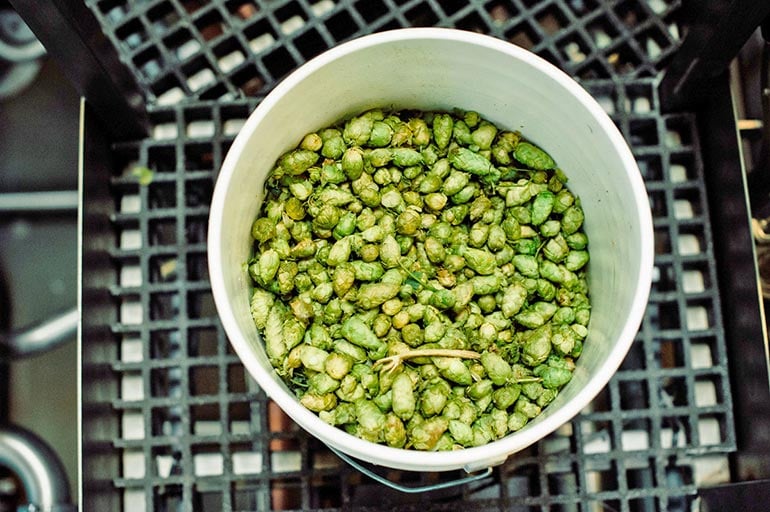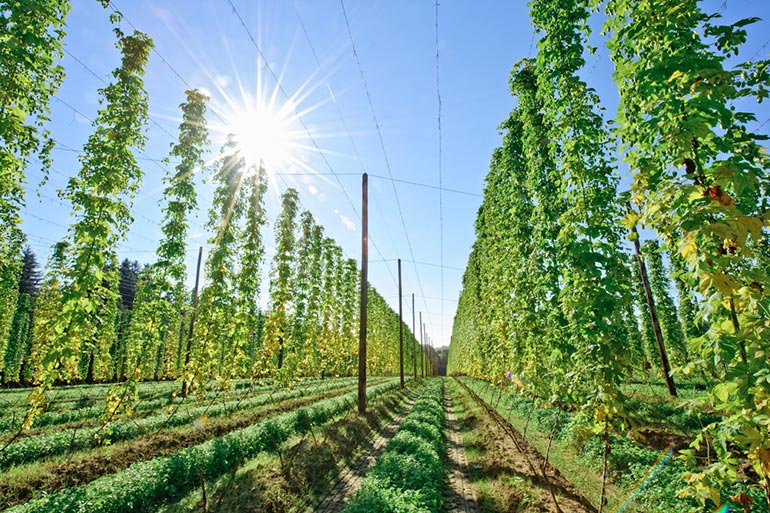Start 14-Day Trial Subscription
*No credit card required

Everything You Need to Know About Hops (and Much More)
Here's an in-depth look at everything you need to know about hops, as well as how four popular hop varietals affect flavor, aroma and other characteristics.
DO THE MATH
To achieve desired characteristics, brewers must be familiar with several equations.
Extraction efficiency, or utilization rate: The efficiency of the isomerization of the alpha acids as a function of time. It is affected by factors such as boil time, boil vigor, wort gravity and pH, which means the equation may be different for each brew. So why bother? It’s important to know when brewers need to scale up or replicate a recipe.
Hop bitterness units (HBU), or hop bitterness coefficient: A formula developed by homebrewing pioneer Fred Eckhardt that helps calculate the bitterness of a homebrewed beer in lieu of the sophisticated equipment required to measure IBUs. The alpha acid percentage is multiplied by the number of ounces to be boiled, so 1.5 ounces of hops at 8 percent alpha acids = 12 HBUs. Brewers also can use the formula when they have to substitute one hop varietal for another in a particular recipe (not uncommon due to the challenges of supply and demand). For example, 3 ounces of hops at 5 percent alpha acids could be substituted for 2 ounces of hops at 7.5 percent alpha acids.
Sophisticated equipment helps ensure consistency in commercial brewing. For dedicated homebrewers, online calculators and software can help achieve desired hop characteristics, and data can be shared through BeerXML.
FOUR POPULAR HOP EXAMPLES
The primary factors brewers must consider when choosing hops are adherence to style and tradition, but they also take into account how the hops will complement other beer characteristics, such as the malt, esters and water mineral profile. While there are myriad different varieties of hops here’s a closer look at four popular hops and how they are used.
Cascade
The most popular hop in craft brewing today was developed by the USDA’s hop breeding program and released to brewers in the 1970s. Its name comes from the Cascade mountain range in Oregon and it is considered the first American-bred aroma hop. Cascade hops are known as the hops that launched a craft beer revolution when Anchor Steam used it to create Liberty Ale, the first IPA brewed after Prohibition. Sierra Nevada Pale Ale is another well-known example that employs the Cascade varietal. Alpha acids are in the 5 to 8 percent range, typical for an aroma/dual-purpose hop.
Cascade’s aroma is citrusy, often described as having a grapefruit-like character, and has distinct floral notes. Dr. Thomas Shellhammer, a professor of fermentation science at Oregon State University, said at a beer conference in Belgium that Cascade set the stage “for a whole wave of very fruity, citrusy, tropical flavored hops” that have arrived more recently and represent the future of hop breeding in the U.S.
Mosaic
This patented varietal, developed by a private company in the Yakima Valley, burst onto the craft beer scene in 2012. With high alpha acids, around 10.5 to 14 percent, its popularity stems from the complex “mosaic” of aromas it offers – tropical fruit, citrus, berry, pine, grass, spice and more. Its unique qualities are what make it so sought after, says Bruce Wolf of Willamette Valley Hops, noting that demand has exceeded the available supply. Mosaic can be found in just about any style today, though it is most often used in IPAs and Pale Ales.
This hop is so hot right now that many beers even feature “Mosaic” in the name, such as Breckenbridge Brewing Company’s Mango Mosaic and pFriem Family Brewers’ Mosaic Single Hop Pale. pFriem Family Brewers Brewmaster and Co-Founder Josh Pfriem said they began experimenting with Mosaic even before it was released to the market and have featured it as part of their “Single Hop Pale” series, which involves trying new or unfamiliar hops with the same base beer, a strong pale ale.

pFriem Family Brewers’ Mosaic Single Hop Pale is an example of a beer that showcases Mosaic, a newer varietal in high demand.
Photo Courtesy pFriem Family Brewers
“We have put many hops through this program and few have been able to create such full and complete flavors as Mosaic. This year’s beer really highlights the fresh melon and papaya attributes of the hop,” Pfriem said. He also noted that clearly marketing beers around specific varietals can help more knowledgeable consumers compare how different breweries use the same hop.
Galena
Galena’s name comes from the Roman word for the mineral galenite, which is found in Oregon’s soil. Another product of the USDA breeding program, it was one of the first “high alpha” hops that helped perpetuate the obsession with increasingly bitter brews. Galena, considered a “clean” bittering hop, has been popular among both commercial brewers and homebrewers because its high alpha acids (13 to 15 percent) impart a clean or mellow bitterness that can be complemented by finishing or aroma hops.
More recently, brewers have been turning to Galena for its aroma characteristics: sweet fruits, grapefruit, lime, blackcurrant and spicy wood. Galena can be found in styles ranging from Barleywines to Stouts to Brown Ales.
On the macro brewing side, Galena is used in Corona Extra. A dramatically different example of Galena hop usage comes from Tröegs Independent Brewing’s Nitro Chocolate Stout.
Hallertau
Hallertau is a region in Bavaria, Germany, rather than a single hop, and some varietals are grown in Washington and Oregon. They are one of four so-called “noble hops” used in early European beers that are still in use today. Hallertau, or Hallertauer, varietals are typically characterized as having a spicy, floral, earthy or herbal aroma. Alpha acids are usually around 3.5 to 6.5 percent, and while versatile, most Hallertaus are used as aroma hops.
Often associated with lagers, Hallertau hops can be found in a range of styles, from Pale Ales to Hefeweizen to Kölsch. One of the most famous examples is the Sam Adams Boston Lager, which is brewed with Hallertau Mittelfrüh and Tettang Tettnager hops. Hangar 24 Craft Brewing’s 24 Blonde Ale is a recent craft example; the Hallertauer hops were used to add just a touch of bitterness (it has only 14 IBUs). Beyond Hallertau, Tettnanger is another popular variety that is produced in Germany.
While the U.S. and Germany are known for their production of different hop varieties, Australia and New Zealand have also become popular hop production hubs in recent years.
THE FUTURE OF HOPS
Bruce Wolf of Willamette Valley Hops says the two main categories of hops are giving way to a third: hops sought after for their flavor. Mosaic, Citra, Galaxy and other fruity or tropical hops all fall into this category. These are the kinds of hops that brewers can use to craft unique brews that will help them stand out in a crowded field.
And while growers and suppliers grapple with developing new varietals and ensuring their availability, Tim Kostelecky at Haas says hop research is looking at how to reduce process loss in brewing IPAs and other styles where a significant volume of hops is required, as well as creating advanced products from carbon dioxide-extracted hop components that can help brewers amp up flavor (or fine tune specific flavors) more efficiently.
Most brewers – scientists at heart – will admit they enjoy experimenting with hops for the pure joy of it, that the thrill of the occasional success outweighs any failures. What will they cook up next? We can’t wait to find out.

Photo Courtesy pFriem Family Brewers





Comments
Pages